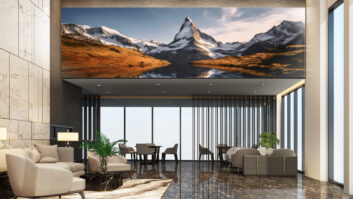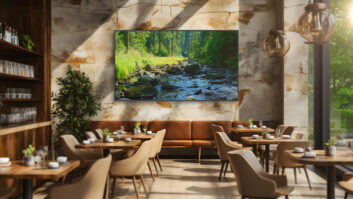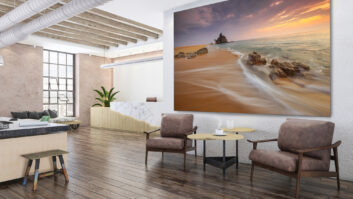2022 is shaping up to be a pivotal year for residential display technologies. QD-OLED (Quantum Dot-OLED) is looking to make its consumer debut this year, even as regular OLED shifts up a gear in performance, and Ultra Short Throw projection, courtesy of its Laser TV alter ego, is giving projection a new lease of life.
Arguably, the most intriguing new screen development is QD-OLED. Long anticipated, it fell to Samsung Display to make the technology official at CES 2022. QD-OLED combines the recognised benefits of OLED, specifically superior black level performance, with Quantum Dot’s increased colour volume and brightness.
STEADY TRACTION
David Sidebottom, lead market analyst at Futuresource Consulting covering media and entertainment, believes this new display option will gain steady traction in the medium term, with Sony and Samsung actively promoting.
“QD-OLED is broadly similar to OLED in that it uses self-emissive pixels, but there are differences,” he says. “Whereas OLED is presently considered to be the only type of display capable of true black, QD-OLED is better for reproducing high brightness images, up to 2000 nits, and with improved colour range.
“Arguably it’s still a OEM push rather than consumer pull. Most mass-market customers don’t really engage with technology until considering a TV purchase, and then they make decisions on more than just video quality, including connectivity and audio support.”
 While Samsung Display explained the technology at CES, it was left to Sony to actually announce product, specifically the Master Series QD-OLED A95K, which will ship in 55- and 65-inch screen sizes later this year.
While Samsung Display explained the technology at CES, it was left to Sony to actually announce product, specifically the Master Series QD-OLED A95K, which will ship in 55- and 65-inch screen sizes later this year.
Samsung is expected to announce its first QD display models soon, initially in 55- and 65in screen sizes.
In the meantime, W-OLED, as championed by LG Display, powers ahead. LG has announced a new version of its premium Evo OLED panel design, which uses Brightness Boosting technology achieved through improved heat dissipation. This new Evo panel will debut in the brand’s hang-on-the-wall, CI-friendly Gallery screens.
“Displays are constantly evolving, and each technology has their unique benefits,” says Stuart Tickle, MD of distributor AWE. “Micro LED certainly offers many benefits, but the technology is at such a premium price that evolutions of OLED make a lot of sense. In terms of pure image quality, OLED delivers the best performance, so we’re excited to see QD-OLED emerging from two major players.”
So what screens is AWE recommending for residential installs right now? “Sony has always been right up there in terms of pure image quality due to its processing and lens-to-living room experience, but LG has been at the forefront with gaming and its Gallery OLED, in terms of aesthetics,” says Tickle.
“Panasonic also offers a superb all-in-one solution featuring built-in speakers if a separate system is not desired. But, it’s hard to ignore the might of Samsung pushing QLED…”
Gaming is beginning to have a significant impact on specifications and usage, particularly within media rooms. An uptick in next gen games console ownership has thrown a spotlight on screen connectivity, with HDMI 2.1 4k 120Hz support increasingly seen as a prerequisite for media room installations.
“HDMI 2.1 is a vital addition for new installations, since it allows devices to deliver audio visual experiences at the highest resolution, frame rates and quality”, says Sidebottom. “HDMI 2.1 is standard on leading games consoles, enabling high refresh rates, and is now being introduced across UHD Smart TVs throughout 2022.
“The headline feature for HDMI 2.1 is support for 4Kp120 and 8Kp60 natively, but also including support for Variable Refresh Rate (VRR), Dynamic HDR, and Quick Media Switching. Then there’s also eARC support for AV receivers and soundbars, delivering the audio quality alongside to build a far more immersive experience. Gaming just happens to be the application showcasing the most promise in showcasing all the elements today.”
MEDIA ROOMS
“In years gone by everyone wanted a cinema room, and while that phrase is still the most common expression used, what we really sell now are media rooms, it’s just that some have a dedicated cinema room aesthetic!” says AWE’s Tickle. “What I mean is that these are usually entertainment spaces, family rooms used for movies, Netflix, gaming, live sports etc. So, HDMI 2.1 is essential for the premium movie experience brought by HDR, but with 4k 120fps being perfect for gamers.”
Panasonic and Philips have both been quick to follow the lead of LG and Samsung, with a Game Bar interface on their 2022 models.
The Pansonic Game Control Board conveys frame rate, HDR metadata and chroma sub-sampling data, while a Dark Visibility Enhancer allows the player to adjust the near black portion of dark scenes so that they can better spot enemies lurking in the shadows. Expect to see it on the top of the range LZ2000 OLED.
LARGE DISPLAYS
The trend toward larger displays also continues apace. LG has announced an 83in model for 2022, providing a new option between 97- and 77in OLED models, while Panasonic has announced a 77in screen for its premium LZ2000 model, calling it ‘Master OLED Pro Cinema Size’. LG is also offering a smaller OLED, just 42in.
 Meanwhile, Samsung is ramping up support for Micro LED technology in 2022, and has announced picture technology improvements and integrated Dolby Atmos audio. The brand has also added an 89in option, expanding install opportunities.
Meanwhile, Samsung is ramping up support for Micro LED technology in 2022, and has announced picture technology improvements and integrated Dolby Atmos audio. The brand has also added an 89in option, expanding install opportunities.
This year, Micro LED modules will support a 20-bit greyscale depth, with Dolby Atmos delivered via top, side, and bottom channel speakers. But the price remains prohibitive.
“There’s little reason for Micro-LED to oust projection in theatres any time soon,” says Tickle. “One of the biggest benefits is the self-lit technology’s ability to perform in higher brightness spaces. By nature, home theatre and commercial cinema tends to be in a darkened environment, so the benefits are reduced. A £10k projector gives you a native 4K laser picture easily able to fill a 3.5m screen in controlled lighting. A user may want Micro-LED for a media room, but you are talking 20 or 30 times the cost, so this is only for the uber rich. For the most premium and largest home cinemas, a 4m to 6m screen is the biggest likely screen size and that can be achieved with a projector like the Sony GTZ-380, a 10,000 lumen projector that meets 100 per cent of DCI-P3. Yes, it is a £100k visual solution, but one at less than half the cost of Micro-LED.”
LEFTFIELD LASERS
One left field residential proposition to watch out for is Laser TV. Hisense in particular plans to push its two Ultra Short Throw laser projectors hard. Its L5 and L9 Ultra Short Throw laser projectors and screen combos are available in 100- and 120in bundles. The L5 is a 2700 lumens design with a single laser light engine, while the L9 is a 300 lumens model with a triple laser.
“We’re already at the point where consumer TV screen display sizes are bordering on cumbersome, especially in European homes,” says Futuresource’s Sidebottom. “Ultra short throw projection is being positioned as a more sustainable alternative for UHD TV, and especially for 8K content, even if this is not broadcast, primary because laser TV generates larger displays (up to 120in) that are not really feasible using single-sheet display panel technology, but also because the energy costs are similar in delivering an HD, 4K or 8K display at such sizes, so there’s a sustainability angle at play here.”
ENERGY EFFICIENT
Tyrone Hammill, Hisense sales manager, says Laser TVs use 30 per cent less energy over a typical 75in plus display. “They are also more recyclable than a large display, so they are by far the greenest and more efficient TV display technology,” he adds.
 Hammill notes sales in the US have taken off as consumers have appreciated the benefits of Laser TV over a regular panel. “The adoption of Laser TV in Europe has been slower,” he says, “but I think we need to do more to show installers and customers just how far the technology has come, and why Laser TV will become a serious alternative to large format displays. It is an education process and we will do more this year to engage with consumers who simply don’t know.”
Hammill notes sales in the US have taken off as consumers have appreciated the benefits of Laser TV over a regular panel. “The adoption of Laser TV in Europe has been slower,” he says, “but I think we need to do more to show installers and customers just how far the technology has come, and why Laser TV will become a serious alternative to large format displays. It is an education process and we will do more this year to engage with consumers who simply don’t know.”
Hammill suggests that there are several user cases where Laser TV is a better option than a conventional display. “Creating the cinema experience at home is what Laser TVs do best,” he opines. “The immersive feeling you get from watching a movie at 100- or 120-in, in razor sharp 4K is arguably not only better than a TV but what you would get at your local cinema. The real difference is that you can use it just like a TV for gaming, movies, and sport.. They’re also easier on the eyes, because they emit less blue light.”
For many integrators, Laser TV could be the ideal media room display solution, he concludes.
“While I don’t believe it will replace a dedicated cinema altogether, for others the simplicity of installing Laser TV combined with the extra power and colour will be compelling. They offer a home theatre for a fraction of what it would normally cost and as the technology matures, projectors will get smaller and easier to integrate into furniture.”
INCOMING TECH
Of the new technologies incoming, Owen Maddock, owner of Cinemaworks, a CEDIA member, says: “I’m not sure there is a ‘big winner’ to be had – new technologies come along, they have an impact in that they allow system designers like us to do things we couldn’t do before. That’s great because we can say ‘yes’ more often.
“So for example, QD-OLED – that’s like OLED but more energy efficient and brighter – is great but not relevant to ‘home cinema’ screen sizes. Mini-LED: for many years to come this is only going to be relevant for those with very serious budgets, at ’normal’ price points projection gives us the scale we want for sensible money, and Laser TV is just an fun re-branding of ultra-short throw projection which has been with us for many years.”
When it comes to Micro LED, Maddock isn’t convinced it’ll oust traditional projection in larger custom installation projects.
“It’s not all about ‘can I watch this in a bright room’,” he says. “If you’re going to be properly immersed in a film or a box set, you’ll turn the lights down anyway. Humans have always gathered round the fire to tell and hear stories. The darkness fuels the imagination – that’s really core, really primal stuff.
“Not just that but projection systems do have a technical advantage that you can put speakers behind the screen, so when an actor is talking, the sound is coming from exactly the right place, not above or below.”
 As a member of the RP22 working group on home cinema standards, Maddock believes that’s one of the big issues right now: how to deliver truly immersive, convincing sound when you can’t put speakers behind the screen? And while “top minds” are working on that, it’ll take a while to get there, he reckons.
As a member of the RP22 working group on home cinema standards, Maddock believes that’s one of the big issues right now: how to deliver truly immersive, convincing sound when you can’t put speakers behind the screen? And while “top minds” are working on that, it’ll take a while to get there, he reckons.
Maddock concludes: “I can see projection ending up a bit like vinyl which is still really popular – maybe it’s less good on paper but it still makes you feel good, a bit magical even. At the end of the day it’s all about how it makes you feel.”
AMAZON ADDITION
And where, you may well ask, does this all leave 8K? Jeff Bezos’ Amazon pointedly joined the 8K Association at the end of 2021. Should the trade read anything into the move?
Chris Chinnock, executive director at 8K Association, is keeping his cards close to his chest. “I think it is safe to say that Amazon are doing their homework. They see 8K is coming and they want to understand all aspects of this developing ecosystem.
“If they were to offer an 8K streaming service, they would need to be very knowledgeable about content capture and production in addition to the encoding and delivery details.”
When it comes to the high-end residential displays market, custom install and AV, how significant will 8k prove in 2022, and beyond? Chinnock says it’s still an early adopter’s game.
“2022 is still going to be a year for forward thinkers who have the funds to support a more expensive, albeit, higher quality video solution,” he says. “8K TV sales will increase and prices will come down, but native 8K content will still be scarce.”
Chinnock says the 8K Association is “looking to do its part” by authoring several white papers and guidelines on the production and delivery side.
“We are working to solve the production and distribution challenges to enable major streamers to want to author and stream in 8K. We’re not too worried about the TV side as history has shown the prices will come down and drive a larger installed base – another requirement for a major 8K service provider.”
What’s clear is that 2022 and beyond marks perhaps the biggest potential step change in residential display technology. It’s going to be some ride, so residential integrators should strap in!







